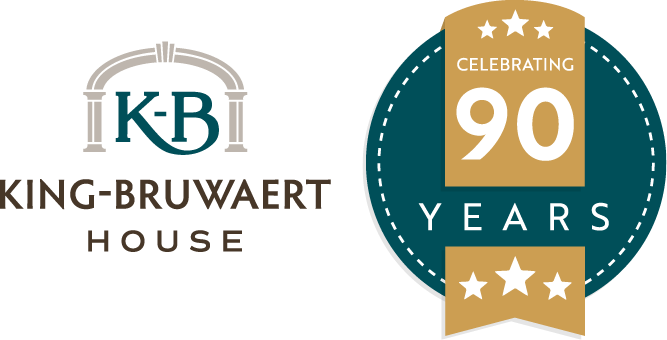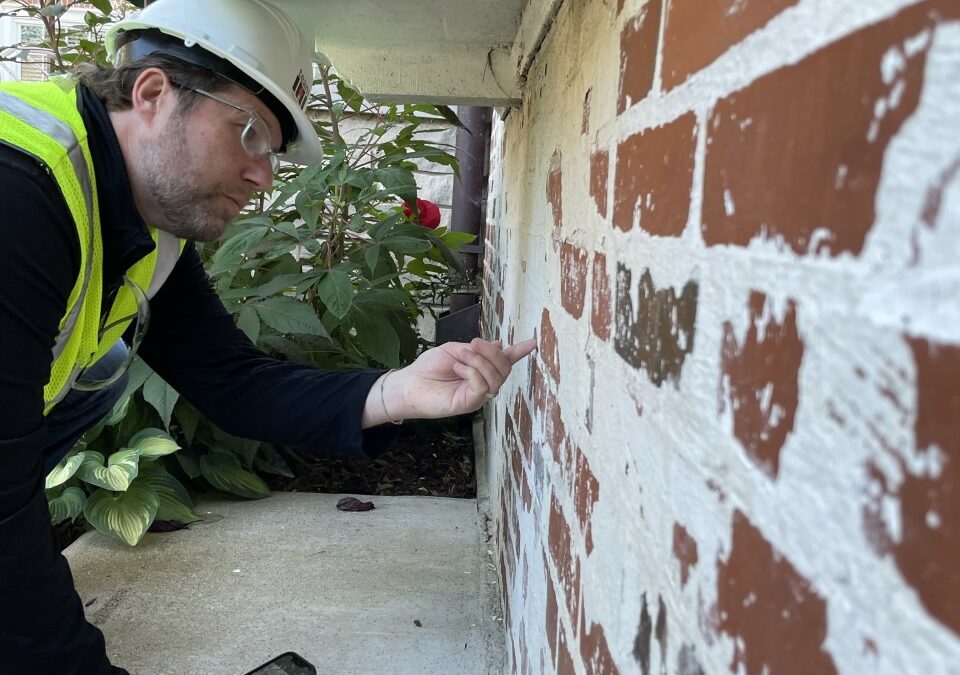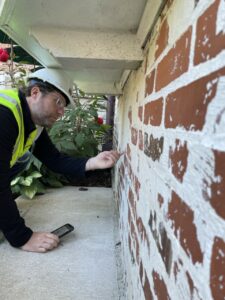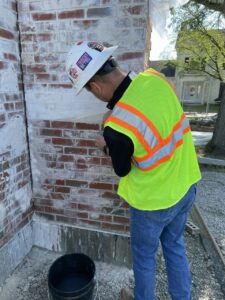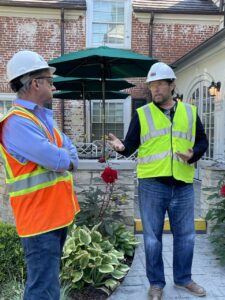When Jeff Diqui first visited the King-Bruwaert House (KBH) senior living community in Burr Ridge, IL, he recognized an “expansive, majestic building nestled in mature trees.” The KBH entrance, so welcoming with its white-washed, red brick walls and ornamental touches, reminded him of the regal nature of European architecture and masonry. “It brought me to Europe with the feelings of warmth and permanence,” he said. Diqui’s carefully chosen words, warmth and permanence, aptly describe the exterior décor and the interior decorum of the highly revered King-Bruwaert House. For Diqui, the charm and elegance of the Georgian Manor home not only engaged his artistic senses, but also his professional skills and knowledge.
An engineer for more than 30 years and the current Director of Industry Development & Technical Service for the International Masonry Institute (IMI), Diqui was invited to visit the KBH campus two years ago to share his expertise relating to masonry applications. His extensive knowledge stems from world travels, both personal and professional, to historic sites where he has had the opportunity to review, study, and recommend options to restore or recreate masonry projects. He works with a seasoned team comprising other engineers, architects, construction managers, historic preservationists, and certified, experienced craftworkers – all with specific roles in guiding and providing project support.
Those who work for IMI, a non-for-profit organization based in Bowie, MD with local offices throughout the United States including Addison, IL, not only bring technical education to the masonry industry, they also conduct detailed project research that closely aligns the original structures with new or restorative designs. In addition, IMI, through its sister organization, the International Masonry Training & Education Foundation (IMTEF), provides training, certifications, and continuing education for current and future generation craftworkers who learn to sustain the skills of yesteryear plus adapt to new technologies and practices. IMI is a partnership between members of the International Union of Bricklayers and Allied Craftworkers (BAC) and the contractors who employ them.
During early stages of the King-Bruwaert House projects, the IMI team was called in to evaluate the topical application of the existing masonry that is now 90 years old. They determined the featured application was German schmearing. This type of European-style schmearing is defined as a finishing technique in which a craftworker uses a trowel and/or brush to schmear mortar onto a brick wall. There is no single, defined technique with project work since the aesthetic can vary, according to Diqui. For example, in the case of replicating a weathered appearance that provides a mottled look, the technique may include removing material off to expose parts of the brick. This schmearing technique can be seen on age-old castles, cottages, and notable buildings throughout northern Germany and Europe. The schmear adds a rough texture, creating a rustic look – and, in cases, where material is weathered, may take on a distressed appearance.
When the KBH estate opened in 1933, black and white photos depict the structure to be 100% coated by the white schmear. A history wall at KBH reveals the original artistry that gave KBH a striking presence along the stretch of County Line Road that bridges Cook and DuPage Counties and the villages of Hinsdale and Burr Ridge. During the span of nine decades, moisture and exposure to the elements contributed to some deterioration of the original shmearing work. Still, enough of the schmear remains to give the building a time-held appearance that reflects its European influence.
Maintaining the original look of KBH has always been a priority given the storied history of the Manor Home that dates back to the Chicago World’s Fair (Columbian Exposition) of 1893. During the six-month fair, founder and benefactor, Suzanne Abby King, met Francois Edmond Bruwaert, a decorated lawyer, who served as the French Consul General to the United States, and as an international commissioner of the Exposition. Suzanne married Monsieur Bruwaert in May, 1894 and the two traveled extensively throughout Europe, with the ambassador representing France on many important diplomatic assignments. During the couple’s travels, they recognized and appreciated the exceptional healthcare available in Europe, as well as the tranquil settings they found to be restorative and comforting.
After Monsieur Bruwaert’s passing in 1927, Suzanne created a hand-written will that specified the bulk of her $3 million estate would be used to build a peaceful home for single or widowed “gentlewomen, not younger than 60”, who would live out their final years with gracious and exceptional care and security in a cheerful, pastoral setting. Suzanne died in 1928, and the directives of her will were carried out by her nephew and another trustee who used estate funds to purchase a 35-area land site, close to Hinsdale, to fulfill her final wishes. Suzanne’s love of nature and tranquility were paramount considerations when the property was acquired.
Construction of the King-Bruwaert home began in 1931 and the doors officially opened in April, 1933. The first female residents settled into a comfortable lifestyle with excellent food, daily activities, and personalized care in a stately setting surrounded by tall, mature trees and gardens, both floral and vegetable. Throughout the years, a long succession of KBH directors and administrators approved renovations and improvements to the campus in response to changing needs of the senior adult population. Following a merger with the nearby Godair Home in 1979, KBH was able to legally change its charter and welcome men and couples to their growing continuous care community.
Most recently, KBH embarked on a much-anticipated reconstruction of its skilled nursing center. The new, state-of-the-art nursing unit, will consist of two 14-bed neighborhoods, located on the north side of the building, and is expected to be completed in spring, 2023. The masonry and architectural look of the new addition is designed to match the original construction and facade of the Manor Home.
IMI/IMTEF instructor Stan Kulasik has the important task of providing guidance of the schmearing process once the masonry work begins. His role as an apprentice coordinator and instructor is to train the current and next generation of craftworkers to refine or develop their masonry skills to preserve and sustain the craft. As a third generation masonry specialist, Kulasik teaches his apprentice teams to take time and pride with their work, especially with historic, architecturally significant buildings such as KBH, that need careful attention to detail. “Masonry is a skill and a craft,” Kulasik said. “If built well and maintained or restored properly, masonry buildings will be here for many generations to come.” Kulasik said the craftworkers assigned to KBH will be using mock-ups to dial in and refine the application techniques and practice the schmearing process to best replicate the existing building appearance. They will also review drawings and photos of the building. Once the skilled nursing building is completed, the masonry specialists will next review KBH plans for a new independent living center, The Gardens of King-Bruwaert House, to be constructed just east of the existing Manor Home. Plans call for 43 luxury apartment homes with amenities to be completed in Winter, 2023-24.
The new, all masonry Georgian red brick Gardens residential building will be connected to the Manor Home, providing year-round convenience for residents and staff. In keeping with a strong focus to blend the Gardens’ exterior masonry with the rest of the campus, the brick will be highlighted with the schmearing technique to maintain the classic look. Once again, craftworkers will be called in to share their skills and artistry. “As we expand and renovate our KBH campus, so much attention has been spent on the details of maintaining our remarkable European legacy,” said CEO Terri Bowen. “We are very proud of our history and make every effort to honor all those who have come before us and created a strong foundation for the future.” History will repeat itself and an enduring, European-inspired masonry technique will blend the past with the present at KBH. Perhaps more importantly, KBH will continue to maintain its distinctive, celebrated presence in the community – one that can only be described as majestic.
By Bonnie R. Kohout, King-Bruwaert House
In collaboration with Jeff Diqui, International Masonry Institute
Photo cutlines:
- Jeff Diqui of the International Masonry Institute (IMI) reviews original schmearing on the King-Bruwaert House building.
- IMI and IMTEF instructor Stan Kulasik looks over a mock-up wall with varying mortar applications to refine the application technique of the schmearing process.
- Jeff Diqui & Mike Cachey, President with BAC Signatory Mason Contractor, Cachey Construction, discuss the original KBH building and the methods to be used for the scope of work.
